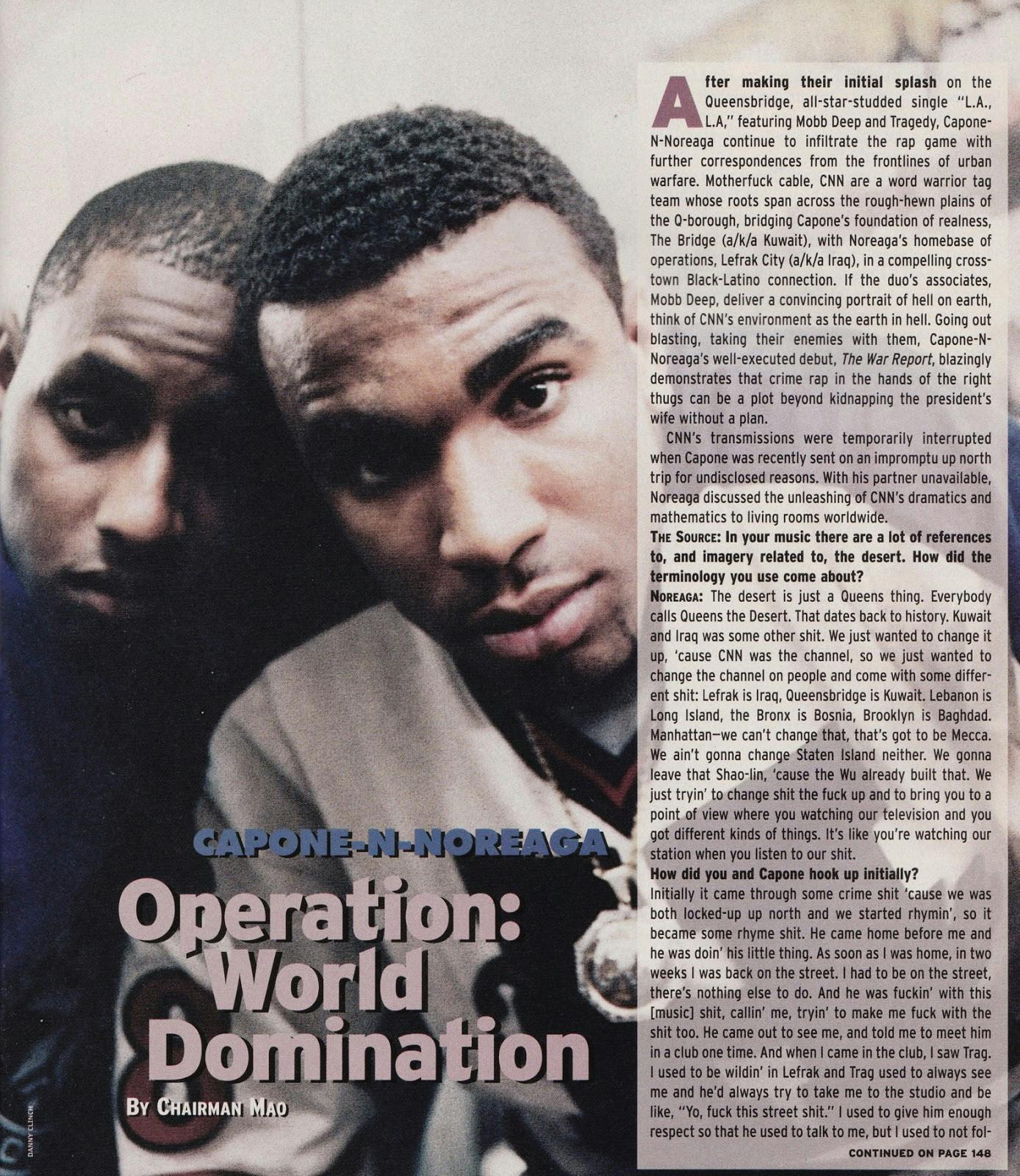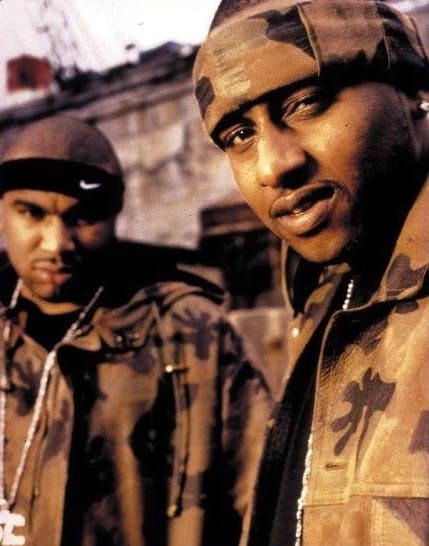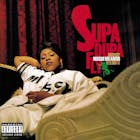
Classic Albums: 'The War Report' by Capone-N-Noreaga
Classic Albums: 'The War Report' by Capone-N-Noreaga
Published Fri, June 17, 2022 at 12:00 AM EDT
The origin of Capone-N-Noreaga is one of Hip-Hop's most unique. The duo out of Queens would take East Coast Hip-Hop by storm in the summer of 1997, on the strength of a classic debut and a whole lot of controversy.
Kiam Holley and Victor Santiago, Jr. had met while both were doing stints at Green Haven Correctional in upstate New York. They were both from Queens (Holley had grown up in the infamous Queensbridge Projects and Santiago was from nearby LeFrak City) either realized the other had musical aspirations, as they bonded over a love of basketball. But Holley had been rapping under the alias "Capone," and he was paroled before Santiago. Once he was free, Capone linked with an old friend and mentor named Percy Chapman, the rapper previously known as Intelligent Hoodlum. He was now going by Tragedy Khadafi, and Tragedy helped Capone land a record deal with Sony.
"I was dealing with Faith Newman," Capone explained to VladTV in 2015. "She signed Fugees. She signed Nas. She believed in me. And I also was messing with Butt Naked Tim Dawg." But he hadn't reconnected with Santiago.

"We was in jail together," Capone reflected. But there was no group at all yet. "[In jail] we was playing basketball. When we both went to the parole board together; and it just so happened that it was his first parole board, but it was my second parole board. I made my second parole board, so I was going home." Soon, Santiago was released, as well. The two reconnected as friends, but still didn't go any further. "They became friends, but didn't start rapping," Tragedy explained in 2015. Capone goes upstate and meets Jam-Master Jay and Jayo Felony and Tragedy Khadafi.
"I come home. He gotta do the rest of his bid," Capone said. "During that time we kept in contact. He hit me one day like 'yo wassup nigga, iIm home.' I go snatch him up, take him shopping. I go get us both some Tommy Hilfiger shit."
It was Tragedy who initially got Capone recorded. But then he ultimately puts Capone and Santiago, who is now rapping under the moniker Noreaga, together as a duo.


Tragedy had met Noreaga as a youngster, when the rapper then known as the Intelligent Hoodlum was asked by NORE's older sister to offer words of mentorship to her troublemaking little brother. But he was now being reintroduced to Victor, Jr. now as an aspiring emcee. But Capone jumped at the chance to team up with his friend. "I seen an opportunity where I could get my brother some money, too, and we could make it happen," Capone explained to XXL. "So that’s we were going to do. We grouped up and became a team as C-N-N and then Trag took it from there. He molded us ’cause we wasn’t seasoned. We never been in the studio, so he really molded us and taught us how to make records and that’ll always be my brother.”
Capone-N-Noreaga began to build a steady buzz throughout 1995 and into 1996. The duo came with important co-signs: from Tragedy Khadafi, and also from Mobb Deep. The Mobb had broken big out of Queensbridge in 1995, and seemed to be opening the door for C-N-N to successfully walk through. "Illegal Life," the pair's first commercial single, featured a co-production credit to Havoc of Mobb Deep, cementing their connections. It also made it clear that C-N-N was going for hardcore street rap, but the times were rapidly embracing something shinier. Penalty Recordings was the label where C-N-N had landed, but now there was a joint deal with Tommy Boy on the table. Bigger money meant bigger expectations; and with things moving quickly, C-N-N needed a more radio-ready single.
"This is the totally honest story: They was like, ’Nore you got to do the chorus,'" N.O.R.E. shared in 2010. "I said, ’No problem! I love doing hooks.’ [But] I had absolutely nothing for the chorus. I simply looked to the right and to the right was a reel that said T.O.N.Y. Nashiem and Carlos Broadway had a company called T.O.N.Y., which meant Top of New York. So I was looking at they reel, because back then we had the two-inch reel, and the reel said T.O.N.Y. And I just took the words, 'T-O-N-Y, invade NY, multiply.' This was not genius. I did not think of it ten years prior. I just looked at the reel, I saw the T.O.N.Y., and I thought that sounded dope so I added to it. Years later people would be like, ’Yo that was so genius!’ But in all honestly it was just so random."
“That song actually came about in a way where we was trying to mess with Bad Boy and get a great big buzz going because Puff was the man at the time with production and everything," Capone added. "No matter how shiny-suit Puff was, he still had the hardest artist in Big. Big was doing shiny suits too. So what the fuck? Big is soft? Nah, it was just the era."
"Top Of New York (T.O.N.Y.)" became the kind of radio hit C-N-N needed. The song announced Capone-N-Noreaga as the next duo out of Queens to storm the industry, but it would be an earlier single that would make them notorious before they'd even become household names.

The East Coast/West Coast friction was being galvanized by media attention; as fans and commentators couldn't get enough of the ever-escalating drama. When California rap superstars Tha Dogg Pound and Snoop Doggy Dogg showed up in Red Hook, Brooklyn to film the music video for their single "NY, NY," shots were fired.
“We went up to the radio station to get at [Funkmaster] Flex," Snoop said in a 2018 interview with Rap Radar. "So we could let everybody in New York know that ‘we brought our lowriders out, we’re shooting a video, all the New York rappers, come fuck with us, nigga—we out here! Come be a part of this video. We get down wit’ y’all.’ But Flex froze us, like, ‘Nah, y’all can’t come up.’"
Snoop said that a phone call into the radio show from The Notorious B.I.G. caused things to escalate. When Biggie called Flex on the radio and said "Brooklyn, stand up!" Snoop interpreted it as a call to arms. Afterwards, shots were fired. And Snoop and Tha Dogg Pound responded by famously kicking down New York City skyscrapers in the song's video. “Ay, ay, ay—Biggie and them caused that,” Snoop interrupts. “And that’s all in the art of war. And because we didn’t try to fuck him up—because we had so much love for him. Me and my team, we loved Biggie. So we took it on the chin, like, ‘Fuck.’ We didn’t even say nothin’. Like, nigga, this my first time ever sayin’ somethin’. We acted like it didn’t happen. But the homies were hot. Death Row was hot."
C-N-N and Mobb Deep linked to respond to the perceived disrespect from the West Coast rap stars. Over beat from legendary Queensbridge producer Marley Marl, the two groups and Tragedy unload on SoCal, albeit without explicit venom for the Left Coast. Even as they were recording "L.A., L.A.," everyone involved was unsure if Tha Dogg Pound song was a proper diss or no.
"That’s why if you really listen to 'L.A., L.A.,' the concept is dissing them but the actual song has no disses at all," N.O.R.E. would explain years later. "The thing was, as we was listening to 'New York, New York,' we couldn’t find no disses from them either. So we just figured we’ll respond the same way they attacked us."
Once the song was done, Profile Records demanded they removed Prodigy's verse. Prodigy had taken a much more direct tone with his lyrics, and the label was worried about the controversy.
"He was the only person indicating a diss," N.O.R.E. shared. "So his label took him off the record. And the final verdict of that was the only person Tupac actually dissed was Prodigy, the person who took the verse off the record. I always thought that was ironic as hell."

The concept is dissing them but the actual song has no disses at all. The thing was, as we was listening to 'New York, New York,' we couldn’t find no disses from them either..."
- Noreaga, (COMPLEX intvw, 2010)
The War Report dropped at the height of mafioso rap and just as "The Shiny Suit Era" was kicking into full swing. The radio-friendly approach of Bad Boy Records had become the go-to recipe for platinum plaques; dropping slick, R&B-drenched singles intended to draw non-rap fans into Hip-Hop's audience. And it had worked: throughout 1996 and into 1997, rap acts were suddenly dominating mainstream radio with singles that showcased polished R&B hooks. But The War Report forsook the shininess, offering something grittier and more street at a time when it was desperately needed. The emergence of DMX in 1998 gets a lot of credit for being the antidote to all of the slickness, but C-N-N. also fired an important shot for hardcore street rap at the time.
After Capone's stint in prison and N.O.R.E.'s breakthrough as a solo artist, C-N-N would reconvene for 2000s The Reunion and 2009s Channel 10 and 2010s The War Report 2: Report The War. And there has been a third War Report in the works for years. The principles involved all understand that lightning doesn't strike twice, particularly not decades after the fact, but they revisit their most famous work for good reason.
"Keep that integrity energy and that pulse that we initially had with The War Report," Tragedy would say in 2014. "Realistically, you can’t recreate something over again. You can duplicate it and nine times out of ten with an album of that magnitude; you won’t necessarily get the same effect because it's a different time. Time is not the same. Life is not the same, and we are not the same. To try to mimic that, it could be fruitless."
The success of The War Report proved to be something of a double-edged sword for C-N-N. They would play up their tough, prison-buddy backstory by typifying gangsta cliches in interviews, including an incident where a VIBE interview ended in some gunplay. They were embracing the infamy and pushing the envelop. “We were emulating N.W.A,” N.O.R.E. recalled about his first VIBE interview in 1997. “We wanted Sacha Jenkins to have this experience like N.W.A.”
Capone wouldn't get to enjoy the fruits after The War Report set them on the path to stardom. He would be set back to prison in 1997 for violating his parole while they were still doing promo for the album. Noreaga would sign with Loud Records as a solo artist and quickly re-emerge as N.O.R.E., armed with that uniquely distinct flow and an armload of infectious production from a duo out of Virginia who called themselves The Neptunes. His solo debut N.O.R.E. would go gold in 1998. Even as C-N-N's journey had endured it's twists and turns, the legacy of their debut album remains.
"For the most part, Penalty did real good withThe War Report," Khadafi told XXL in 2014. "Penalty did real good with N.O.R.E. and helping kind of alley-oop that with Tommy Boy [Music]. I think Neil Levine, he knows what he's doing. He knows how to put the right people in place. He’s respected in the machine."
The War Report is the result of two charismatic newcomers, the influence and talent of their mentor, and a winning balance between hardcore and polish. A song like "T.O.N.Y." gave them just enough sheen for the radio, but the album's heart and soul lies with unapologetic street rap. For fans who wanted something with heart, soul, heat and fire, there was no better representer for East Coast Hip-Hop. Throughout The War Report, Capone-N-Noreaga (and guest star Tragedy Khadafi) make their bid for hardcore rap immortality on their debut. Polished enough for the mainstream, gritty enough for the streets, it announced these two hungry emcees from Queens as a force to be reckoned with.






